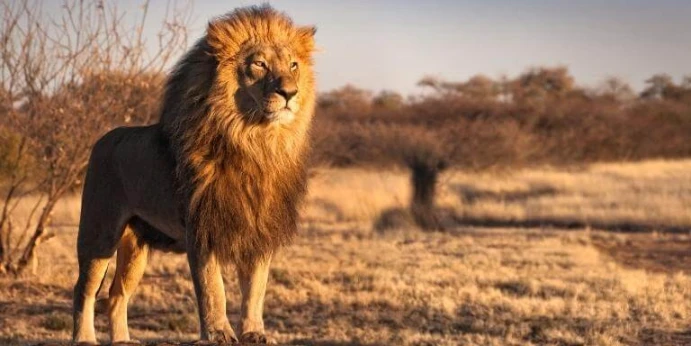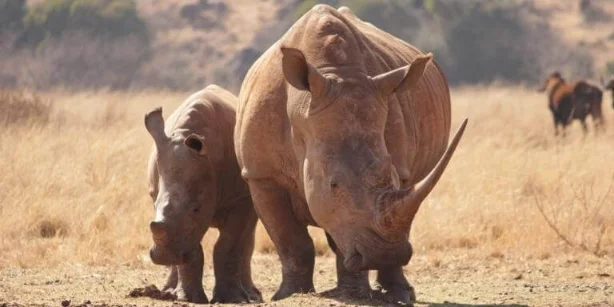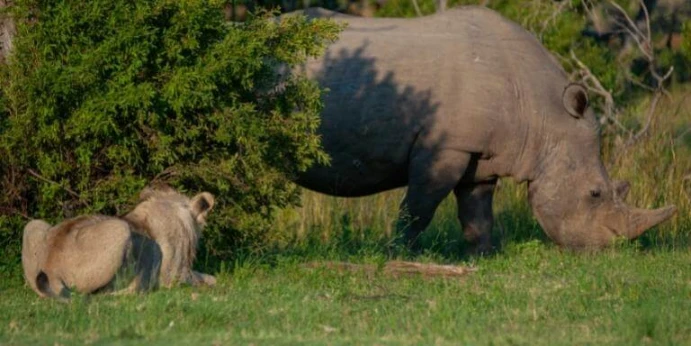Lions, preferring savanna and grassland habitats, spend much of their time in the bushes. They are less sociable than the other cats. They sleep and rest for around 16 to 20 hours each day. Lions are voracious eaters. It is during storms; they go out hunting.
On the other hand, the Rhinos need the broad undulating forest, as well as plenty of grass and permanent water sources. Rhinos are less aggressive and considerably more social in nature, and they travel in groups of approximately 15 members.
In this article, we will show all the comparisons between these two mammals. We have chosen ranges of factors such as classification, diet, habitat, ranges, and many others for contrasting between these two giant animals. Keep reading till the end as there is some information which will definitely amuse you.

Lion vs Rhino – Comparison Chart
A comparison chart of white rhino versus lion is shown below. The table below can help you grasp their distinct characteristics, such as type, diet, weight, and size.
| Comparison with | Lion | Rhino |
|---|---|---|
| Scientific Name | Panthera leo | Rhinocerotidae |
| Type | Mammal | Mammal |
| Diet | Carnivores | Herbivores |
| Size | 1.8–2.1 m tall | 3.4-4.2 m tall |
| Weight | 330 to 550 pounds | 1,320 to 2,090 pounds |
| Behavior | Behavior Spend much of their time resting; they are inactive for about twenty hours per day | Solitary animals and can be quite aggressive |
| Population | Population 20,000 left in the wild | Around 27,000 remain in the wild |
| Range | Africa, south of the Sahara Desert | Tanzania south through Zambia, Zimbabwe, and Mozambique |
| Habitat | Broad plains, dense scrub, and dry thorn woodland | Tropical and subtropical grasslands, savannas, and shrublands |
| Lifespan | Up to 16 years. | Up to 35-50 years. |
Rhinoceros vs lion – Classification
The lion (Panthera leo), along with the tiger (Panthera tigris), leopard (Panthera pardus), and jaguar ( Panthera onca), is an Old-World mammal of the Felidae family and one of four species of “big cats” in the Panthera genus.

Rhinoceroses are huge herbivorous animals distinguished by their horned snouts. The term “rhinoceros” is derived from the Greek words “rhino” (nose) and “ceros” (horn). There are five rhino species and 11 subspecies; some have two horns, while others only have one.

Size
The lion is a big, muscular cat with a long torso, a massive head, and short legs. Size and appearance differ significantly between sexes. The male’s distinguishing feature is his mane, which varies across individuals and communities.
A fully mature male is around 1.8–2.1 meters long (excluding the tail). They stand about 1.2 meters tall at the shoulder and weigh 170–230 kilograms. With a body length of 1.5 meters, a shoulder height of 0.9–1.1 meters, and a weight of 120–180 kilos, the lioness is found to be smaller.
The average Rhinoceros, on the other hand, stands 66.0″-81.0″ (1.7-2.1 m) tall and has a body length of 132.0″-165.0″ (11′-13’9″). (3.4-4.2 m). A normal Rhinoceros weights between 3,500 and 8,800 lb (1,600-4,000 kg) and lives for 35-40 years.
Weight
The weight of rhinos varies based on the species. Their weight ranges from 1,320 to 2,090 pounds on average. The black rhino is the lighter of the two African rhino species. Their weight ranges from 1,720 to 3,080 pounds. The white rhino weighs more than other African species, weighing between 3,080 and 7,920 pounds and towering between 5 and 6 feet tall.
Nonetheless, lions generally weigh 330 to 550 pounds (150 to 250 kilograms), with males reaching the upper end of that range.
Diet
Lions are carnivores, which means they enjoy eating meat. Lions primarily prey on big mammals weighing 100 to 1,000 pounds (45 to 453 kilograms), such as zebra and wildebeest.
In times of scarcity, they will also trap and devour a range of smaller animals, ranging from mice to reptiles. Lions also prey on hyenas, leopards, and other predators. They may occasionally lose their own captures to hyena packs.
Domestic cattle may also be eaten by lions, especially in regions near communities. Lions can consume a LOT of food! Male lions consume an average of 7kg of food per day, whereas lionesses consume 4.5kg. Both are capable of consuming up to 15% of their body weight in a single meal.
That’s the equivalent of 70 cans of cat food for a guy! Lions are notorious for their greed, and they will pursue animals even when they are not hungry.
On the other hand, Rhinos are grazers and browsers who consume trees and shrubs for the majority of their food. They pick leaves and fruit from the trees using their mouths. They typically eat at night and throughout the early morning and late evening hours of dawn and dusk.
They seek refuge from the scorching African heat by resting in the shade. White rhinos munch on grasses, their massive heads and squared lips dropped to the earth.

Habitat
Lions live in a variety of environments, including broad plains, dense scrub, and dry thorn woodland. Lions presently exclusively reside in Africa, from the Sahara’s southern border to northern South Africa, with the exception of a tiny population of the Indian lion subspecies that persists in the Gir Forest of northwest India. They are not found in equatorial regions characterized by wet tropical vegetation.
Rhinos’ habitats include tropical and subtropical grasslands, savannas, and shrublands, as well as tropical wet forests, deserts, and shrublands. Their habitat is determined by the species. The Sumatran rhino, for example, lives in deep highland and lowland tropical and subtropical forests.
Speed
With a top speed of 81 km/h (50.3 mph), the lion ranks second among Africa’s fastest land animals.
Rhinos, having less speed than lions, have a top speed of 25-34 mph (40-55 km/h). Black rhinos are the quickest of the rhino species.
Ranges
Nearly all wild lions dwell in Africa, south of the Sahara Desert, with the exception of a tiny population in western India near Gir Forest National Park. West and Central African lions are more closely linked to these Asiatic lions in India than to those found in southern and eastern Africa.
The lion’s original habitat in Africa included the majority of the central rainforest zone and the Sahara Desert. Except for the southern portion of Sudan, it became extinct throughout North Africa in the 1960s. The lion originally roamed southern Europe and Asia, where climatic conditions supported an abundance of prey.
On the other hand, the rhino has four subspecies: South-central (Diceros bicornis minor), the most abundant, once ranging from central Tanzania south through Zambia, Zimbabwe, and Mozambique to northern and eastern South Africa.
The home range sizes of rhino populations vary greatly across the African continent, with the lowest recorded in relatively moist and subtropical HP (3 km2) and the biggest in dry Namibia (e.g., 3,000 km2).
Lifespan
In the wild, an animal’s lifetime is determined by its ability to avoid predators and obtain food. Even though lions are the top predators, they suffer several dangers in the wild and live a shorter life in the wild than in captivity.
In the wild, lions may live for up to 16 years. They live longer in captivity than in the wild. In captivity, they can survive for up to 20 years. They are vulnerable to natural hazards, illnesses, and food scarcity in the wild. In the wild, a lion begins to deteriorate and eventually dies between the ages of 10 and 15 years.
Rhinos, on the other hand, have a longer life expectancy than lions. In the wild, Rhinos live for up to 35 – 40 years, while in captivity, they can survive for up to 40 years. White rhinos are territorial and semi-social.
Rhino vs Lions Who Would Win?
Rhino vs lion clashes always results in exciting outcomes. Lions may be known as the king of the jungle. They may be fearless while attacking the prey, but they too are considerate when it comes to attacking a rhino.
Rhinoceroses are tremendously aggressive creatures. Black rhinos to be exact have no predators except humans in the wild. They are so strong that they can even throw a lion away with a single blow. They appear as a tank on the battlefield in front of the carnivores.
Lions, on the other hand, are massive carnivorous creatures. They are unparalleled fierce beasts with a massive hunger for meat. The lion pride isn’t afraid of anything. The biggest preys they like to capture include the giraffe and the buffalos. It takes about 2 to 3 big cats to take down an adult buffalo. But they also hesitate while attacking a rhinoceros.
Lions don’t usually try to hunt down an animal of such weight. They only show interest in it when the herbivore is in a difficult situation such as being stuck or while drinking water. Even though the horned mammal is immensely heavy. Their armor also acts as an ultra-defensive barrier from outside harm. In addition, though appear to be not, the herbivore is surprisingly agile. They can easily outrun the lion pride.
A mother’s rhinoceros is more protective of her baby than anything else. Their maternal instincts are fearless. Moreover, the baby develops a special bond with her in the wild. As it doesn’t have the tools to protect itself in the wild, it depends entirely on its mother for a certain time period. This companionship can be 4 to 5 years long.
The giant herbivore usually has no potential predators in the wild except for humans. But sometimes lions and the African Nile crocodiles are seen to be interested in hunting them if they are found in a difficult situation.
You might also be interested in:
Rhino vs Hippo | Who Would Win in a Fight?
Elephant vs Hippo | Who Would Win in a Fight?
9 Differences Between Northern and Southern White Rhino
Hippo vs Crocodile | Who Would Win in a Fight?
